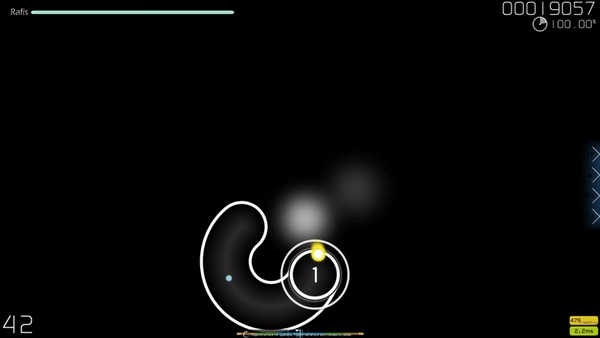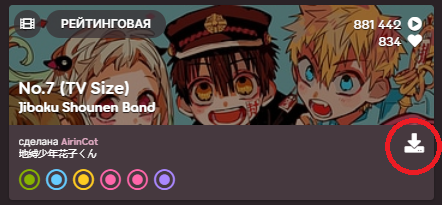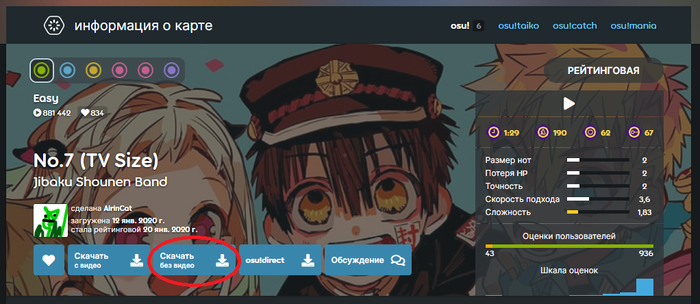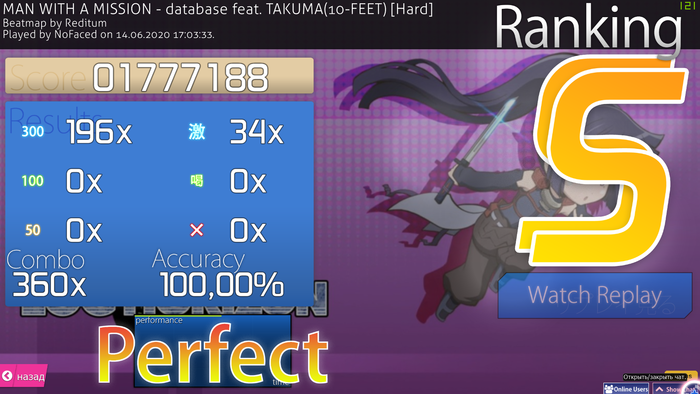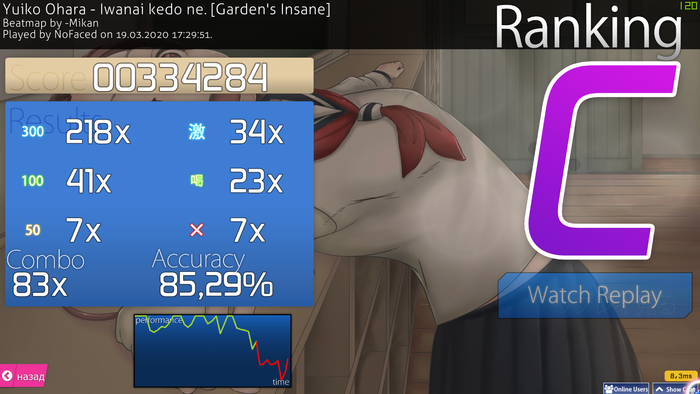touch device osu что это
(Ranked) Touch Device mod for Osu!CTB
Нет аккаунта?
(Ranked) Touch Device mod for Osu!CTB
First of all, this is NOT a simple «Mouse playstyle for Osu!CTB» request, I know there’s a Relax mod implemented for this reason.
This is about playing Osu! Catch The Beat with a Touchscreen device (Ranked)
Here’s some main points that will show why it seems to be as bad as many keyboard/joystick players think about and my proposal to solve the issues.
(Very minor point before: I tried myself playing on my cellphone and this playstyle is harder than it looks, but it’s easier than keyboard/joystick)
1) Osu!CTB and Osu!STD have the same problem with Touchscreen:
Jumps in Standard are (almost) equivalent to Hyperjumps and Sprints in CTB.
(In a performance view, they both have the «aim» and «speed» value)
Therefore simply allowing the Touchscreen playstyle with the keyboard/joystick playstyle won’t work, since people will just abuse the Touchscreen for harder spaced Hyperjumps/Corner sprint jumps.
2) Double Time mod makes the catcher have 1.5x movement for each key input, while using Touchscreen will make that easier (Example: Accuracy on Sliders)
3) Flashlight mod is easier (not that easy), since you only need to remember the place to tap (this might still decrease your accuracy a lot, but will make FC maps a lot easier)
4) Leaderboards on maps made mostly by hyperjumps will be full of Touchscreen players (This is already happening in Osu!STD though, so this point is kind of a reference to the separate leaderboard request as well)
5) Allowing Touchscreen playstyle will automatically add Mouse/Tablet playstyle, because there’s no way to make a difference during the replay/gameplay
6) The catcher can move with a variable amount of speed using Touch Devices/Mouse/Tablet (I’m talking of the Relax mod)
My proposal:
The «no mod» gameplay will still only allow «keyboard/joystick» playstyles and, already implemented for Osu!Standard, we should add a similar Touch Device mod that does these things:
0] You can’t use keyboard/joystick (To make it different from no mod)
1] Must be manually activated (like a mod) from the mod options
2] This will add the possibility for Touch Devices (and mouse/tablet) to control the catcher
3] The speed of the catcher will be fixed like a keypress even with Touch Devices/mouse/tablet (see next point), teleportation is possible only with the Touch Device
(Dragging will be equivalent to sprintless movement and Tapping will be equivalent to teleport)
4] Sprint key can’t be used! (Since Tapping equals to your sprint key and makes accuracy (droplets) harder to get. this way you get both an advantage and a disadvantage)
6] Performance Points should be recalculated in an alternate formula taking in consideration the «aim» and «speed» issues considerated before (also for DT and FL)
The main idea is that no mod pp will be higher than Touch Device mod pp for all maps (not sure if there might be exceptions. but I don’t think there’s a map like that)
7] Leaderboard Osu!CTB + Touch Device problem = Same as Osu!STD (Until STD is not solved, this won’t be as well)
ПОЛНЫЙ (почти) гайд по osu!
Жмем большущую центральную кнопку и переходим в раздел Options.
Также в этой вкладке отмечаем пункты «Игнорировать скины всех карт» (вспоминаем про хитсаунды) и «Свой курсор из скина».
Собственно, пожалуй, всё. С первоначальной настройкой мы закончили. В дальнейшем вы можете спокойно на ходу менять все эти настройки по своему усмотрению.
—Разбираемся с управлением—
Что нужно делать в osu? Проходить карты. Все. Больше ничего. Крайне интересная игра, да?))
Перво-наперво, карты разделяются по сложности. У каждой карты есть название сложности и та же сложность, но в звездах. Название сложности присваивает создатель карты; это может быть как какое-нибудь стандартное «Easy»/»Normal»/»Hard»/»Insane» (от самого легкого к самому сложному), так и полностью выдумка автора. Например, когда в одном наборе карт (про наборы чуток ниже) собирают карты от разных создателей, имена мапперов (создателей) частенько прописывают в сложностях, и в итоге мы видим что-то вроде «Akitoshi’s Hard», «Nely’s Advanced» и т.д. Ниже приведен список наиболее часто встречающихся названий (от легкого к сложному):
Теперь насчет наборов карт. Набор создается одним или несколькими игроками и включает в себя несколько сложностей одной и той же песни. Собственно, наборы мы и скачиваем, после чего просто проходим те сложности, которые хотим. Тренируемся, совершенствуемся, проходим более высокие сложности.
Наконец, о поиске карт. Можно искать по названию, исполнителю, источнику (название аниме/игры/фильма/etc), тегам. Кроме того, обратите внимание на фильтры: можно найти карты лишь определенного режима игры (к слову, этот гайд именно про osu!, а не другие режимы, вроде osu!taiko или osu!mania), статусу рейтинга (по умолчанию поиск ведется лишь по «проверенным» картам, т.е., рейтинговым, одобренным и любимым), жанру, языку и т.д. Для загрузки нужно лишь нажать на соответствующий значок.
Либо можно перейти на страницу карты и скачать оттуда, если, к примеру, вы не хотите загружать карту с видео (тем же опенингом).
Play style
This page will detail the various ways in which players can choose to play in their respective game modes.
Mouse-only
Note: Mouse-only was once the only way to play osu! until other playing methods were supported over time.
Also known as pure-mouse, mouse-only players navigate the in-game cursor with a mouse while tapping beats, following sliders, and spinning spinners with only clicking the left and right mouse buttons.
The play style is widely considered to be the hardest method to play with and mouse-only players who rank high in the overall rankings are usually greatly respected by the community.
Dual mouse
Dual mouse is a play style in which a player has a mouse in each hand; using one mouse to tap and another mouse to move the in-game cursor.
Note: It is also common for dual mouse players to tape the mouse used for clicking to the desk.
Mouse and keyboard
Mouse and keyboard is the most popular play style for osu! because it uses the most basic computer peripherals and puts less strain on the hand used for holding the mouse.
Mouse and keyboard players play in almost exactly the same way as mouse-only players with the only difference being that two keyboard keys ( Z and X by default) are used to tap instead of the mouse itself.
Some players use only the keyboard to tap while others only switch to the keyboard when streaming (the act of tapping a very fast string of hit objects in rapid succession) and use the mouse to click for everything else.
Tablet-only
Notice: This play style requires the use of a graphics tablet (digitizer).
Tablet-only players hover a tablet pen over a graphics tablet to navigate the in-game cursor and only tap beats by tapping the pen onto the surface of the graphics tablet itself.
Streaming with only one tapping input is widely regarded in the community to be nearly impossible at high BPM. Thus, to stream as a Tablet-only player, a player should alternate between tapping their pen onto the tablet and pressing one assigned secondary key (usually a tablet or keyboard key). This method is sometimes referred to as tapx.
Tablet and keyboard
Notice: This play style requires the use of a graphics tablet (digitizer).
Tablet and keyboard is a popular play style among many passionate, competitive, and top players.
Tablet and keyboard players «hover» or «drag» a tablet pen to navigate the in-game cursor and tap beats using the keyboard or the tablet buttons.
Much like mouse and keyboard, some players also use only the tablet pen to tap while others will switch to keyboard when streaming.
Touchscreen
This play style uses a touch-enabled monitor, laptop screen, or tablet to navigate the in-game cursor and tap hit objects.
To navigate the in-game cursor, touchscreen players touch the screen of their device with a tablet pen or their finger at the precise location in which they want the cursor to be at. This results in the cursor to appear as if it is «jumping» to the touched location.
When a touchscreen player taps the screen, their device will simultaneously move the cursor to that point, as well as send a mouse input. Thus, to tap beats, follow sliders, and spin spinners, touchscreen players will only touch hit objects when they want the hit object to be hit.
This play style may feel similar to playing osu!stream due to the act of touching the screen directly rather than moving a cursor.
Touchscreen and keyboard
Touchscreen and keyboard is a play style uses a keyboard for key inputs, and touchscreen device of some sort to navigate the in-game cursor; it is a play style most often adopted by touchscreen players who cannot perform streams using only the touchscreen.
Other styles
osu!taiko
Keyboard
Keyboard was once the only way to play osu!taiko until other playing methods were supported over time.
Simply, the player would press the assigned keyboard keys to hit the drum parts. By default, X / C were for the drum center (Red) and Z / V were for the drum rim (Blue).
There are two main styles of setting the keys placement in the keyboard: KDDK (Taiko default, or BRRB) or DDKK/KKDD (or RRBB/BBRR). The letters represent the placement of the drum rim or drum center (e.g. K in KDDK for drum rim, and D for the drum center).
Note: For key-binding, the default is Z X C V (KDDK, or BRRB).
Taiko controller
A taiko controller is the default play style and controller for the Taiko no Tatsujin series(Taiko Drum Master for US).
Note: Some skilled players who play using a Taiko controller may create theirs from scratch while others purchase theirs via retail or online stores.
Players who use a Taiko controller carry a Taiko/drum stick in each hand and hit the center (Red) or rim of the drum (Blue) to register the note based on where it is hit.
Notice: Most Taiko controllers connect to the computer by using a Bluetooth connector should there be no USB connecter. Though this may increase latency
Other styles
osu!catch
Keyboard
A keyboard is the most commonly used and default play style for osu!catch.
To play with a keyboard, players press the left and right arrow keys to move the catcher and hold down leftShift to dash.
It is possible to edit the keys used; some players enjoy A / D for movement and the spacebar or rightShift to dash.
Keyboard and mouse
Keyboard and mouse is a minor alternative play style of keyboard, in which players can dash using mouse clicks instead. Though some players prefer the reverse and prefer to control the left and right movements by using the left/right mouse buttons and activate dashes with the keyboard.
Joystick
Using a joystick to control the catcher is a play style for players who are used to pixel-old arcade cabinets’ control scheme.
Players move the head of the joystick and press the face button, trigger, or keyboard key to dash.
Gamepad
Using a gamepad to control the catcher is a play style for players who prefer the feeling of a particular D-pad or control stick as opposed to a keyboard.
To move the catcher left and right, some players prefer to press the left/right arrows on their gamepad’s D-pad to move, while others prefer to use control stick directions. Though, due to a gamepad’s wide variety of buttons, players can use triggers, bumpers, or other face buttons to move the catcher.
To dash, many players use one of the face buttons on their gamepad. Though, some players prefer to use triggers, bumpers, or control sticks.
Other styles
osu!mania
Keyboard
Keyboard was once the only way to play osu!mania until other play methods was supported over time.
To play with a keyboard, players would press down the keys respective to their placement on the in-game keyboard. By default these keys are DFJK. The advantage of this play-style is that it can accommodate basically all the Keys setting.
Arcade controller
Arcade controllers from other rhythm games such as DJMAX, O2Jam, Beatmania IIDX, etc. are a play-style tuned for seasoned veterans at conveyor-type rhythm games.
Note: Since the use of 8 Keys requires the mapper’s decision or the use of game modifiers, most players owning these arcade controllers can handle up to 7 keys (max default) and 1 special.
Dance pad
Dance pads are controllers for games like the Dance Dance Revolution (DDR) series, and the Pump It Up (PIU) series. (StepMania is a semi–well known, community-driven clone of both of these games).
To play with a dance pad, players «dance» on the dance pad to input commands. DDR pads have 4 panels: Up, Down, Left, and Right. DDR Solo pads add Up-Left and Up-Right to that. PIU pads have 5 panels: Up-Left, Up-Right, Down-Left, Down-Right, and Center. Some 9 panel pads also exist for the purpose of compatibility with both PIU and DDR without having to change a pad. Normal DDR and PIU pads are often used in doubles mode in their respective games, where one player uses 2 pads for a song. DDR Solo games were all single-player, so they aren’t commonly doubled.
A major drawback with using a dance pad is that it can be hard to hit multiple keys at once. To hit 4 notes on a DDR pad, you would either have to use your hands along with your feet to hit them, or position your feet on 2 panels at once.
Another drawback is that osu!mania maps may have been designed without dance game chart flow in mind, limiting the amount of charts you can (comfortably) dance to. Dance games are often charted with dancing chart flow. One big rule of charting for a dance game like DDR is mostly being able to switch feet for every note (with some exceptions). Since some osu!mania maps don’t really follow those rules, which can make it really awkward to play a lot of maps on a dance pad.
Using iOS or Android device as tablet style controller
Нет аккаунта?
Using iOS or Android device as tablet style controller
This post has been updated as of Jan. 20, 2021! I confirmed that TouchProxy and TUIOdroid will still work. The EcoTUIODriver link has been updated to a newer version, but I couldn’t get it to work outside of the preview window.
If anyone can confirm whether or not the iOS app link below still works, let me know! The app hasn’t been updated in a while but it still shows up in searches, there’s a chance it only works on older devices.
If you have problems, try running the desktop server as administrator!
So I’ve been using this while waiting to be able to get a real tablet. This allows you to use any iOS or Android device that can install the app as an absolute tablet style controller.
First off, install the Desktop and Mobile app that works with what you have (good luck getting tuiopad on Android otherwise).
Open up the desktop app to make sure it configures, and check the port it is set to.
NOTE: It may help to run as administrator. I got this working on Windows 10, but not until I ran it as admin.
Next, on your mobile device open the TUIO app and enter your computer’s local IP address and the port.
Then just turn on the service from the desktop app and you have touch control! It registers as if you were touching on a Tablet PC, so it’s like continuously holding down the mouse.
Remember to set osu! to use a mouse sensitivity of 1 or the cursor will spaz endlessly.
NOTES: For TUIODroid, you have to enter the menu to change the IP. This can be done by hitting the menu button if your phone is old enough to have one, or by shaking the phone if you have a modern Android phone without a menu button.
Interface
Main Menu
The osu!cookie [1] pulses according to the BPM of any song currently playing on the main menu. In addition, bars will extend out of the osu!cookie in accordance to the song’s volume. If no song is playing, it pulses at a slow 60 BPM. The elements of the main menu are as follows:
User Options
Access this screen by clicking your profile at the top left of the main menu. You cannot access the Chat Consoles while viewing the user option screen. You can select any item by pressing the corresponding number on the option:
Play Menu
Multi Lobby
Song Selection Screen
You can identify the current mode selected by either looking at the icon in the bottom left, above Mode, or by looking at the transparent icon in the center of the screen. These are the four you will see:
Before continuing on, this screen has too many elements to note with easily, noticeable numbers. The subsections below will focus on one part of the screen at a time, starting from the top down and left to right.
Beatmap Information
This area displays information on the beatmap difficulty currently selected. By default, the beatmap whose song is heard in the osu! jukebox is selected when entering the selection screen. In the top left is the ranked status of the beatmap. The title is next. Normally, the romanised title is shown, but if you select Prefer metadata in original language in the Options, it will show the Unicode title; this is shown in the upper picture. The beatmapper is also shown, and beatmap information is shown below. From left to right, the values are as follows:
Group and Sort
Click on one of the tabs to sort your song list according to the selected criterion.
The first five groupings are available in tabs below Group and Sort.
Search
Note: You cannot have the chat console or the options sidebar open if you want to search; otherwise, anything you type will be perceived as chat text or as an options search query.
Only beatmaps that match the criteria of your search will be shown. By default, any search will be matched against the beatmaps’ artists, titles, creators, and tags.
In addition to searching these fields, you can use filters to search through other metadata by combining one of the supported filters with a comparison to a value (for example, ar=9 ).
You may also enter a difficulty or beatmap ID number in your search to get a single result.
Rankings
A variety of things can appear in this space:
These are the view settings:
*Requires you to be an osu!supporter to access them.
Click the word bubble icon to call up the Quick Web Access screen for the selected beatmap:
While you are on the Quick Web Access Screen, you cannot access the Chat and Extended Chat Consoles.
The song list displays all available beatmaps. Different beatmaps may have different coloured boxes:
You can navigate the beatmap list by using the mouse wheel, using the up and down arrow keys, dragging it while holding the left mouse button or clicking the right mouse button (previously known as Absolute Scrolling), which will move the scroll bar to your mouse’s Y position. Click on a box to select that beatmap and display its information on the upper left, high scores (if any) on the left and, if you’ve cleared it, the letter grade of the highest score you’ve achieved. Click the box again, press Enter or click the osu!cookie at the lower right to begin playing the beatmap.
Gameplay toolbox
List of available game modes
This section can be called the gameplay toolbox. We will cover each button’s use from left to right.
Press Esc or click the Back button to return to main menu.
The background transparent icon and the «Mode» box will change to depict what mode is currently selected.
Mod Selection Screen
Click the Mods button or press F1 to open the Mod Selection Screen.
In this screen, you can apply modifications («mods» for short) to gameplay. Some mods lower difficulty and apply a multiplier that lowers the score you achieve. Conversely, some mods increase the difficulty, but apply a multiplier that increases the score you achieve. Finally, some mods modify gameplay in a different way. Relax and Auto Pilot fall in that category.
Place your mouse on a mod’s icon to see a short description of its effect. Click on an icon to select or deselect that mod. Some mods, like Double Time, have multiple variations; click on the mod again to cycle through. The score multiplier value displays the combined effect the multipliers of the mod(s) of you have selected will have on your score. Click Reset all mods or press 1 to deselect all currently selected mods. Click Close or press 2 or Esc to return to the Song Selection Screen.
While you are on the Mod Selection Screen, you cannot access the Chat and Extended Chat Consoles. In addition, skins can alter the text and/or icon of the mods, but the effects will still be the same.
Click the Random button or press F2 to have the game randomly scroll through all of your beatmaps and pick one. You cannot select a beatmap yourself until it has finished scrolling.
Note: You can press Shift + the Random button or F2 to go back to the beatmap you had selected before you randomized your selection.
Possible commands for a beatmap
Click the Beatmap Options button, press F3 or right-click your mouse while hovering over the beatmap to call up the Beatmap Options Menu for options on the currently selected beatmap.
Click on your user panel to access the User Options Menu.
Click the osu!cookie to start playing the selected beatmap.
Results screen
This is the results screen shown after you have successfully passed the beatmap. You can access your online results by scrolling down or pressing the obvious button.
Note: The results screen may change depending on the used skin.
Below are the results screens of the other game modes.
Accuracy in osu!taiko
Accuracy in osu!mania
Accuracy in osu!catch
Online Leaderboard
An example of an osu!online score
This is your online leaderboard. You can go here by scrolling down from the results screen. Your Local Scoreboard will show your name and the score as usual.
Above is what it looks like to receive a medal.



